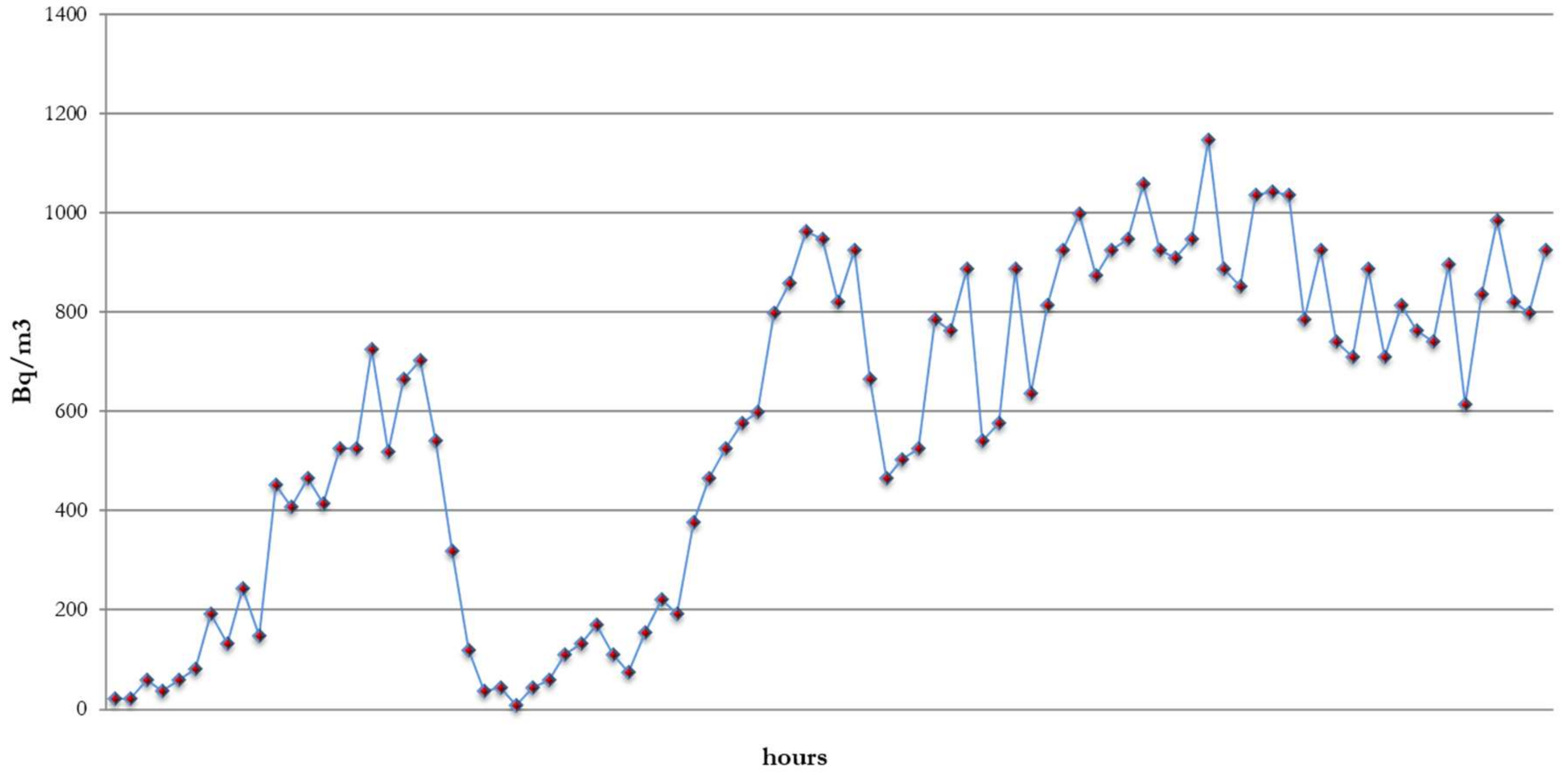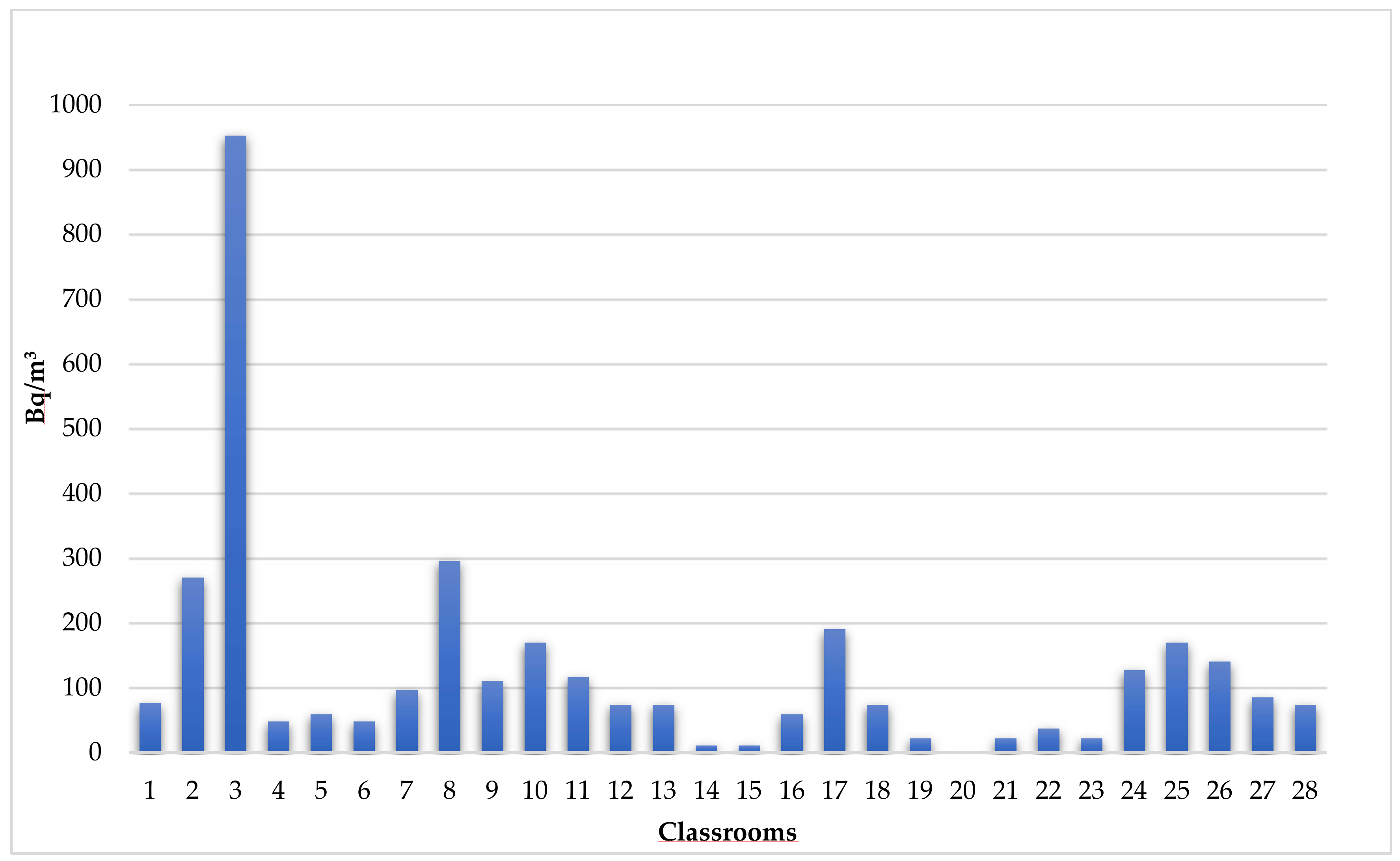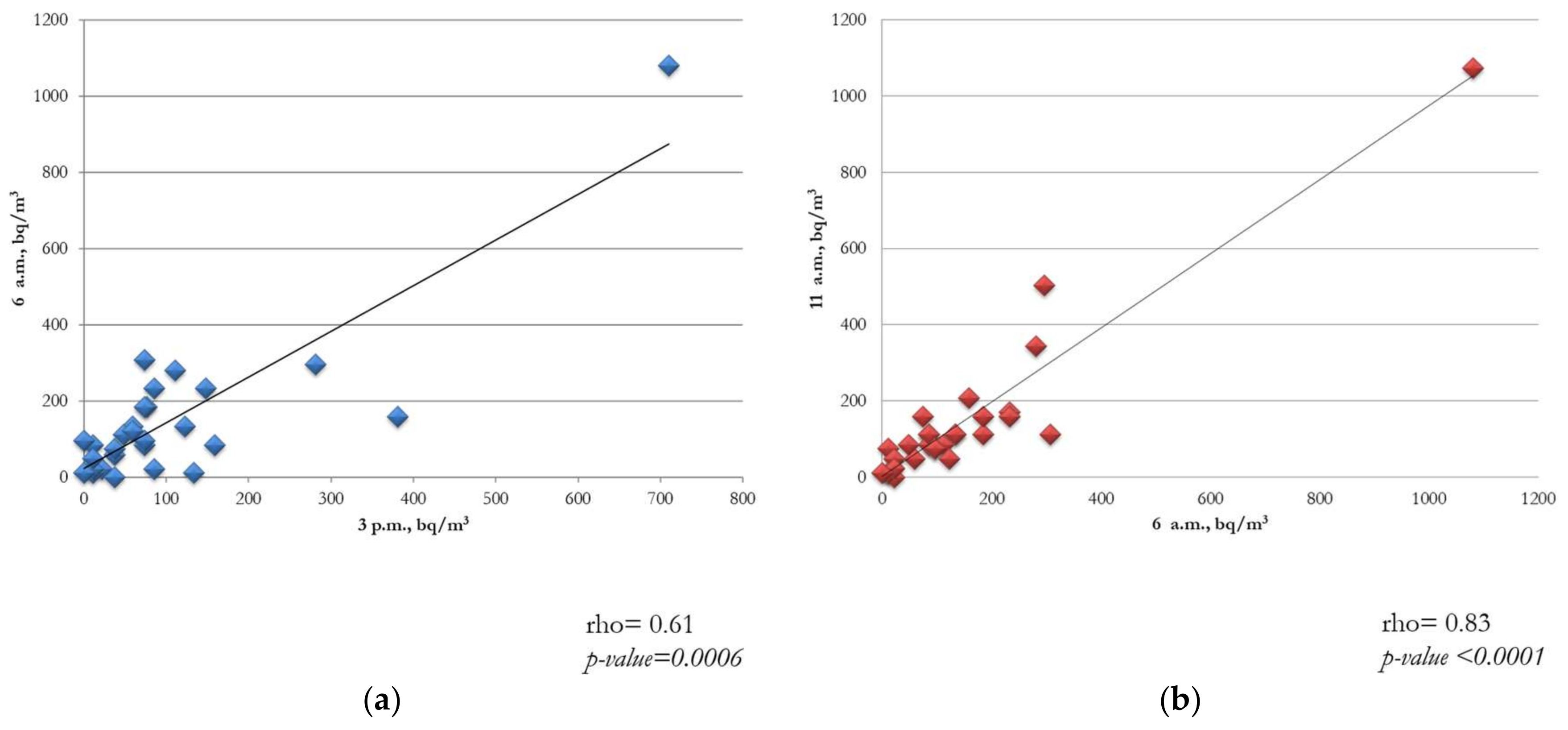Indoor Radon Exposure in Italian Schools
Abstract
1. Introduction
2. Materials and Methods
2.1. Study Design
2.2. Setting
2.3. Radon Concentration Measurement
2.4. Statistical Analysis
3. Results
3.1. Buildings Characteristics
3.2. Radon Baseline Detection
3.3. Geological Evaluation
4. Discussion
5. Conclusions
Acknowledgments
Author Contributions
Conflicts of Interest
References
- International Agency for Research on Cancer. Man-made mineral fibres and radon. IARC Monogr. Eval. Carcinog. Risks Hum. 1988, 43, 1–300. [Google Scholar]
- WHO. Who Handbook on Indoor Radon—A Public Health Perspective; World Health Organization: Geneva, Switzerland, 2009; p. 110. [Google Scholar] [CrossRef]
- National Research Council (US). Committe on Health Risks of Exposure to Radon (BEIR VI); National Academies Press (US): Washington, DC, USA, 1999; ISBN 0-309-05645-4.
- Sá, J.P.; Branco, P.T.B.S.; Alvim-Ferraz, M.C.M.; Martins, F.G.; Sousa, S.I.V. Evaluation of low-cost mitigation measures implemented to improve air quality in nursery and primary schools. Int. J. Environ. Res. Public Health 2017, 14, 585. [Google Scholar] [CrossRef]
- Bochicchio, F.; Žunić, Z.S.; Carpentieri, C.; Antignani, S.; Venoso, G.; Carelli, V.; Cordedda, C.; Veselinovic, N.; Tollefsen, T.; Bossew, P. Radon in indoor air of primary schools: A systematic survey to evaluate factors affecting radon concentration levels and their variability. Indoor Air 2014, 24, 315–326. [Google Scholar] [CrossRef] [PubMed]
- Foster, S.; Jones, S.E. Association of school district policies for radon testing and radon-resistant new construction practices with indoor radon zones. Int. J. Environ. Res. Public Health 2016, 13, 1234. [Google Scholar] [CrossRef] [PubMed]
- López-Abente, G.; Núñez, O.; Fernández-Navarro, P.; Barros-Dios, J.M.; Martín-Méndez, I.; Bel-Lan, A.; Locutura, J.; Quindos, L.; Sainz, C.; Ruano-Ravina, A. Residential radon and cancer mortality in Galicia, Spain. Sci. Total Environ. 2018, 610–611, 1125–1132. [Google Scholar] [CrossRef] [PubMed]
- Baeza, A.; García-Paniagua, J.; Guillén, J.; Montalbán, B. Influence of architectural style on indoor radon concentration in a radon prone area: A case study. Sci. Total Environ. 2018, 610–611, 258–266. [Google Scholar] [CrossRef] [PubMed]
- Franci, D.; Aureli, T. Long- and short-term indoor radon survey in the Ardea municipality, south Rome. Radiat. Prot. Dosim. 2014, 162, 625–629. [Google Scholar] [CrossRef] [PubMed]
- United States Environmental Protection Agency. Radon in Schools. 2012. Available online: http://www.epa.gov/iaq/schools/webconferences.html (accessed on 12 February 2018).
- Commission Recommendation of 21 February 1990 on the Protection of the Public against Indoor Exposure to Radon (90/143/Euratom). Available online: http://eur-lex.europa.eu/legal-content/EN/TXT/PDF/?uri=CELEX:31990H0143&from=SV (accessed on 12 February 2018).
- Council Directive 2013/59/Euratom of 5 December 2013. Laying down Basic Safety Standards for Protection against the Dangers Arising from Exposure to Ionising Radiation, and Repealing Directives 89/618/Euratom, 90/641/Euratom, 96/29/Euratom, 97/43/Euratom and 2003/122/Euratom. Available online: https://ec.europa.eu/energy/sites/ener/files/documents/CELEX-32013L0059-EN-TXT.pdf (accessed on 12 February 2018).
- Decreto Legislativo Del Governo no 241 Del 26/05/2000 D. Lgs. 241/2000. Attuazione Della Direttiva 96/29/Euratom in Materia Di Protezione Sanitaria Della Popolazione E Dei Lavoratori Contro I Rischi Derivanti Dalle Radiazioni Ionizzanti. Available online: http://www.parlamento.it/parlam/leggi/deleghe/00241dl.htm (accessed on 12 February 2018).
- Ministero Della Salute. Piano Nazionale Radon. 2002. Available online: http://www.iss.it/binary/radon/cont/PNRtesto.pdf (accessed on 12 February 2018).
- Regione Autonoma Della Sardegna. Classificazione Del Territorio Regionale Con Individuazione Delle Aree a Rischio Radon. 2016. Available online: http://www.sardegnaambiente.it/documenti/21_393_20170209132528.pdf (accessed on 12 February 2018).
- Firenze, A.; Calamusa, G.; Amodio, E.; Morici, M.; Di Paquale, M.; Mazzucco, W.; Azara, A.; Muresu, E.; Dettori, M.; Maida, G.; et al. Evaluation of radon levels in indoor gymnasia of Palermo (Sicily) and Sassari (Sardinia). Ital. J. Public Health 2009, 6, 316–322. [Google Scholar]
- Fuoco, F.C.; Stabile, L.; Buonanno, G.; Vargas Trassiera, C.; Massimo, A.; Russi, A.; Mazaheri, M.; Morawska, L.; Andrade, A. Indoor air quality in naturally ventilated Italian classrooms. Atmosphere 2015, 6, 1652–1675. [Google Scholar] [CrossRef]
- Branco, P.T.B.S.; Nunes, R.A.O.; Alvim-Ferraz, M.C.M.; Martins, F.G.; Sousa, S.I.V. Children’s Exposure to Radon in Nursery and Primary Schools. Int. J. Environ. Res. Public Health 2016, 13, 386. [Google Scholar] [CrossRef] [PubMed]
- Buondonno, A.; Grilli, E.; Capra, G.F.; Glorioso, C.; Langella, A.; Leone, A.P.; Leone, N.; Odierna, P.; Vacca, S.; Vigliotti, R.C. Zeolitized tuffs in pedotechnique for the reclamation of abandoned quarries. A case study in the Campania region (Italy). J. Environ. Manag. 2013, 122, 25–30. [Google Scholar] [CrossRef] [PubMed]
- Trevisi, R.; Leonardi, F.; Simeoni, C.; Tonnarini, S.; Veschetti, M. Indoor radon levels in schools of South-East Italy. J. Environ. Radioact. 2012, 112, 160–164. [Google Scholar] [CrossRef] [PubMed]
- Synnot, H.; Hanley, O.; Fenton, D.; Colgan, P.A. Radon in Irish schools: The results of a national survey. J. Radiol. Prot. 2006, 26, 85–96. [Google Scholar] [CrossRef] [PubMed]
- Tunno, T.; Caricato, A.P.; Fernandez, M.; Leonardi, F.; Tonnarini, S.; Veschetti, M.; Zannoni, G.; Trevisi, R. Critical aspects of radon remediation in karst limestone areas: Some experiences in schools of South Italy. J. Radiol. Prot. 2017, 37, 160–175. [Google Scholar] [CrossRef] [PubMed]
- Neuberger, S.; Gesell, T.F. Childhood cancers, radon, and gamma radiation. Lancet 2002, 360, 1437–1438. [Google Scholar] [CrossRef]
- Daisey, J.M.; Angell, W.J.; Apte, M.G. Indoor air quality, ventilation and health symptoms in schools: An analysis of existing information. Indoor Air 2003, 13, 53–64. [Google Scholar] [CrossRef] [PubMed]
- Istratea, M.A.; Catalina, T.; Cucos, A.; Dicu, T. Experimental measurements of VOC and radon in two Romanian classrooms. Energy Procedia. 2016, 85, 288–294. [Google Scholar] [CrossRef]
- Kitto, M. Radon testing in schools in New York State: A 20-year summary. J. Environ. Radioact. 2014, 137, 213–216. [Google Scholar] [CrossRef] [PubMed]
- Turhan, S.; Akyurek, S.; Erdogan, M.; Kurnaz, A.; Altikulac, A. Health hazards due to the exposure to radon in schools of the Cappadocia Region. Nucl. Technol. Radiat. Protect. 2017, 32, 174–179. [Google Scholar] [CrossRef]
- Curguz, Z.; Stojanovska, Z.; Zunic, Z.S.; Kolarz, P.; Ischikawa, T.; Omori, Y.; Mishra, R.; Sapra, B.K.; Vaupotic, J.; Ujic, P.; et al. Long-term measurements of radon, thoron and their airborne progeny in 25 schools in Republic of Srpska. J. Environ. Radio Activ. 2015, 148, 163–169. [Google Scholar] [CrossRef] [PubMed]
- Barros, N.G.; Steck, D.J.; Field, R.W. A comparison of winter short-term and annual average radon measurements in basements of a radon-prone region and evaluation of further radon testing indicators. Health Phys. 2014, 106, 535–544. [Google Scholar] [CrossRef] [PubMed]



| Descriptive Analysis Results | ||
|---|---|---|
| Median (IQR) no. students/teacher | 19 (16–20) | |
| Construction period, n (%) | <1900 | 0/28 (0.0) |
| 1900–1950 | 13/28 (46.4) | |
| 1951–1964 | 9/28 (32.1) | |
| 1965–1979 | 2/28 (7.1) | |
| ≥1980 | 5/28 (14.3) | |
| Underground renovation, n (%) | 3/15 (20.0) | |
| Foundation wall material, n (%) | Wood | 0 (0.0) |
| Cement | 4/28 (14.3) | |
| Stone | 24/28 (85.7) | |
| Flooring, n (%) | Cement | 0 (0.0) |
| Floor tiles | 2/28 (100.0) | |
| Wood | 0 (0.0) | |
| Rubber | 0 (0.0) | |
| Linoleum | 0 (0.0) | |
| First floor above underground floor, n (%) | 2/28 (7.1) | |
| First floor without any underground floor, n (%) | 25/28 (89.3) | |
| External entrance doors, n (%) | 9/28 (32.1) | |
| Usage of the doors, n (%) | 9/9 (100.0) | |
| Windows, n (%) | 28/28 (100.0) | |
| Foundation walls adjacent to a cavity wall, n (%) | 0/27 (0.0) | |
| Foundation walls adjacent to an air cavity, n (%) | 0/27 (0.0) | |
| Foundation walls adjacent to ground, n (%) | 27/27 (100.0) | |
| Foundation rocky walls, n (%) | 0/27 (0.0) | |
| Water infiltration, n (%) | 0/27 (0.0) | |
| Condensate/Humidity, n (%) | 1/27 (3.7) | |
| Heating system, n (%) | 27/27 (100.0) | |
| Afternoon class, n (%) | 2/28 (7.1) | |
| Forced air exchange, n (%) | 0/28 (0.0) | |
| Vacuum system, n (%) | 0/28 (0.0) | |
| Exposed piping, n (%) | 10/28 (35.7) | |
| Piping, n (%) | In the floor | 0/20 (0.0) |
| In the side wall | 28/28 (100.0) | |
| Floor and wall cracks and fissures of undergrounds rooms, n (%) | 0/28 (0.0) | |
| Previous Radon measurement, n (%) | 1/28 (3.6) | |
| Variables | No. Students/Teacher | Construction Period | Foundation Wall Material | Condensate/Humidity | First Floor without Underground Floor |
|---|---|---|---|---|---|
| Construction period | 0.18 | ||||
| p-value | 0.368 | ||||
| Foundation wall material | −0.52 | −0.62 | |||
| p-value | 0.005 | 0.001 | |||
| Condensate/Humidity | 0.13 | −0.20 | 0.08 | ||
| p-value | 0.524 | 0.312 | 0.685 | ||
| First floor without underground floor | −0.31 | −0.08 | 0.28 | 0.06 | |
| p-value | 0.111 | 0.700 | 0.157 | 0.784 | |
| Radon concentration, Bq/m3 | −0.55 | −0.49 | 0.44 | −0.13 | 0.38 |
| p-value | 0.003 | 0.009 | 0.021 | 0.532 | 0.050 |
© 2018 by the authors. Licensee MDPI, Basel, Switzerland. This article is an open access article distributed under the terms and conditions of the Creative Commons Attribution (CC BY) license (http://creativecommons.org/licenses/by/4.0/).
Share and Cite
Azara, A.; Dettori, M.; Castiglia, P.; Piana, A.; Durando, P.; Parodi, V.; Salis, G.; Saderi, L.; Sotgiu, G. Indoor Radon Exposure in Italian Schools. Int. J. Environ. Res. Public Health 2018, 15, 749. https://doi.org/10.3390/ijerph15040749
Azara A, Dettori M, Castiglia P, Piana A, Durando P, Parodi V, Salis G, Saderi L, Sotgiu G. Indoor Radon Exposure in Italian Schools. International Journal of Environmental Research and Public Health. 2018; 15(4):749. https://doi.org/10.3390/ijerph15040749
Chicago/Turabian StyleAzara, Antonio, Marco Dettori, Paolo Castiglia, Andrea Piana, Paolo Durando, Valentina Parodi, Giovanni Salis, Laura Saderi, and Giovanni Sotgiu. 2018. "Indoor Radon Exposure in Italian Schools" International Journal of Environmental Research and Public Health 15, no. 4: 749. https://doi.org/10.3390/ijerph15040749
APA StyleAzara, A., Dettori, M., Castiglia, P., Piana, A., Durando, P., Parodi, V., Salis, G., Saderi, L., & Sotgiu, G. (2018). Indoor Radon Exposure in Italian Schools. International Journal of Environmental Research and Public Health, 15(4), 749. https://doi.org/10.3390/ijerph15040749










